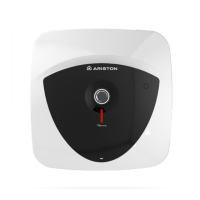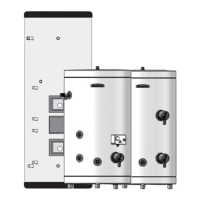operated device to warn when discharge takes place. Note: The discharge will consist of scalding water and steam.
Asphalt, roong felt and non-metallic rainwater goods may be damaged by such discharges.
of withstanding high temperature discharges of water 3 m from any plastic guttering
systems that would collect such a discharge (tundish visible).
iv) Where a single pipe serves a number of discharges, such as in blocks of flats, the
number served should be limited to not more than 6 systems so that any installation
can be traced reasonably easily. The single common discharge pipe should be at
least one pipe size large than the largest individual discharge pipe to be connected.
If unvented hot water storage systems are installed where discharges from safety
devices may not be apparent i.e. in dwellings occupied by the blind, infirm or disabled
people, consideration should be given to the installation of an electronically operated
device to warn when discharge takes place. Note: The discharge will consist of
scalding water and steam. Asphalt, roofing felt and non-metallic rainwater goods may
be damaged by such discharges.
16
Valve outlet size Minimum size of
discharge pipe D1*
discharge pipe D2*
from tundish
resistance allowed,
expressed as a
length of pipe (i.e.
no elbow or bends)
by each elbow or
bend
G 1/2 15 mm 22 mm
28 mm
35 mm
Up to 9 m
Up to 18 m
Up to 27 m
0.8 m
1.0 m
1.4 m
G 3/4 22 mm 28 mm
35 mm
42 mm
Up to 9 m
Up to 18 m
Up to 27 m
1.0 m
1.4 m
1.7 m
G 1 28 mm 35 mm
42 mm
Up to 9 m
Up to 18 m
1.4 m
1.7 m
Table 2
Sizing of copper discharge pipe “D2” for common temperature valve outlets.
Worked example
The example below is for a G 1/2” temperature & pressure relief valve with a
discharge pipe (D2) having 4 no. elbows and length of 7 m from the tundish to the
point of discharge.
From Table 2
Maximum resistance allowed for a straight length of 22 mm copper discharge pipe
(D2) from G 1/2” T & P valve is 9 m.
Subtract the resistance for 4 no. 22 mm elbows at 0.8 m each = 3.2 m.
Therefore the maximum permitted length equates to: 5.8 m.
As 5.8 m is less than the actual length of 7 m there
fore calculate the next
largest size.
Maximum resistance allowed for a straight length of 28 mm pipe (D2) from G 1/2” T
& P valve equates to: 18 m.
Subtract the resistance for 4 no. 28 mm elbow at 1.0 m each = 4 m.
Therefore the maximum permitted length equates to: 14 m
As the actual length is 7 m, a 28 mm (D2) copper pipe will be satisfactory.
42.0.01.07204.03 pag. 9-20.qxd:42.0.01.07204.01 pag. 9-20 7-10-2016 11:28 Pagina 16
Worked example
The example below is for a G 1/2” temperature & pressure relief valve with a discharge pipe (D2) having 4 no. elbows and
length of 7 m from the tundish to the point of discharge.
From Table 2
Maximum resistance allowed for a straight length of 22 mm copper discharge pipe (D2) from G 1/2” T & P valve is 9 m.
Subtract the resistance for 4 no. 22 mm elbows at 0.8 m each = 3.2 m. Therefore the maximum permitted length equates
to: 5.8 m.
As 5.8 m is less than the actual length of 7 m therefore calculate the next
largest size.
Maximum resistance allowed for a straight length of 28 mm pipe (D2) from G 1/2” T & P valve equates to: 18 m.
Subtract the resistance for 4 no. 28 mm elbow at 1.0 m each = 4 m. Therefore the maximum permitted length equates
to: 14 m
As the actual length is 7 m, a 28 mm (D2) copper pipe will be satisfactory.
Draining the appliance
The appliance must be drained if left inactive in a room subject to frost and/or in the event of prolonged inactivity.
Typical drain arrangement and system designs will vary:
1. Turn power o to ensure appliance is not operated when empty.
2. Turn o cold supply to appliance.
3. Shut o hot water feed from appliance.
4. Connect hose to drain cock and place other end in sink, basin etc.
5. Open drain cock and open TPR valve to vent cylinder.

